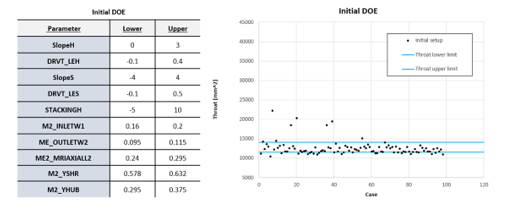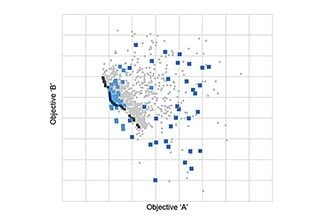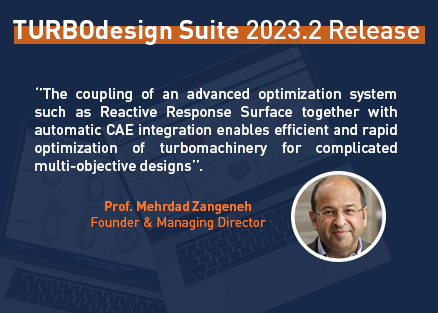One of the most difficult problems in automatic optimisation is how to set the range of design parameters in optimisation, so that you can cover a large design space, but at the same time you don’t get too many infeasible designs that can not be meshed for example in CFD.
Inverse design based optimisation in which the blade loading is parametrised provides a direct means of visually inspecting the feasible range of blade loading. But in some applications where both meridional shape and blade loading are included in optimisation how to set up the range of design parameters could have an impact on success of optimisation. This is especially the case for surrogate model based optimisation where a Design of Experiment (DoE) is run a from relatively small number of geometries, and then these are run in CFD and performance parameters such as efficiency or pressure rise are extracted at several operating points and used in a surrogate model such as Kriging to correlate the design and performance parameters.
Inverse design based optimisation has been shown to give very accurate surrogate models generally. But still important that the DoE is set up correctly. The new range set up functionality for optimisation enables the design parameters range to be set up in such a way that maximize the accuracy of the surrogate model. One interesting feature of the new system is that it can set the range of design parameters in such a way that takes account of design constraints for optimisation.
In order to demonstrate this new system, a design optimisation of centrifugal pump where 4 blade loading parameters and 5 meridional shape parameters are used for optimisation For this optimisation the throat area of the impeller was set to be within +/-10% of baseline to control the location of peak efficiency. An initial range of design parameters set up manually by an ADT engineer is shown in Figure 1 and the corresponding DoE results for Throat area is also shown in Figure 1.

Fig. 1. (Left) Design parameter lower and upper ranges; (Right) Throat area values for generated cases.
We have tested our feature for this case in 2 different ways: first by allowing the script to automatically find the widest design space possible without any constraints, and in a second test by imposing the throat constraints. You can find these results in Figure 2 and Table 2.
Summary of the results are shown in Table 1.
| DOE | Convergence Rate (%) | Acceptance Rate (%) |
| Manual Range | 82 | 60 |
| Automatic Range - No Constrains | 92 | 14.2 |
| Automatic Rang - Constrained | 97 | 75.8 |
For the DoE with manual range set up the convergence rate in TURBOdesign1 ( which is usually a very good measure of the feasibility of design) is 82% versus 92% for automatic range set up with no constrains despite the latter having a larger design space. More interestingly the acceptance rate (percentage of cases in DoE that meet the throat constrains) increase from 60% in the manual design to 76% in the automatic range set up. The combined improvement in convergence rate and acceptance rate by the automatic range set up system will improve considerably the accuracy of surrogate models for complex multi-point, multi-disciplinary optimisation.

Fig. 2. and Tab. 2. (Left) Automatically estimated design parameter lower and upper ranges; (Right) Throat area values for generated cases of estimation without constraints and Throat area values for generated cases of estimation with throat constraints.
You can playback TURBOdesign Suite 2021R2 Release webinar from now on, where you will:
- Learn the new features in TURBOdesign Suite 2021R2;
- Discover how the new features especially for splitter real gas and volute real gas can help to streamline design of chillers, heat pumps and Organic Rankine Cycle Turbines;
- Understand the impact of the new loss prediction capability in TURBOdesign pre centrifugal pump on better prediction of pump stage characteristic.
Mehrdad Zangeneh
Mehrdad Zangeneh is Founder and Managing Director of Advanced Design Technology and professor of Thermofluids at University College London.
View All Articles



.webp)


Share This Post